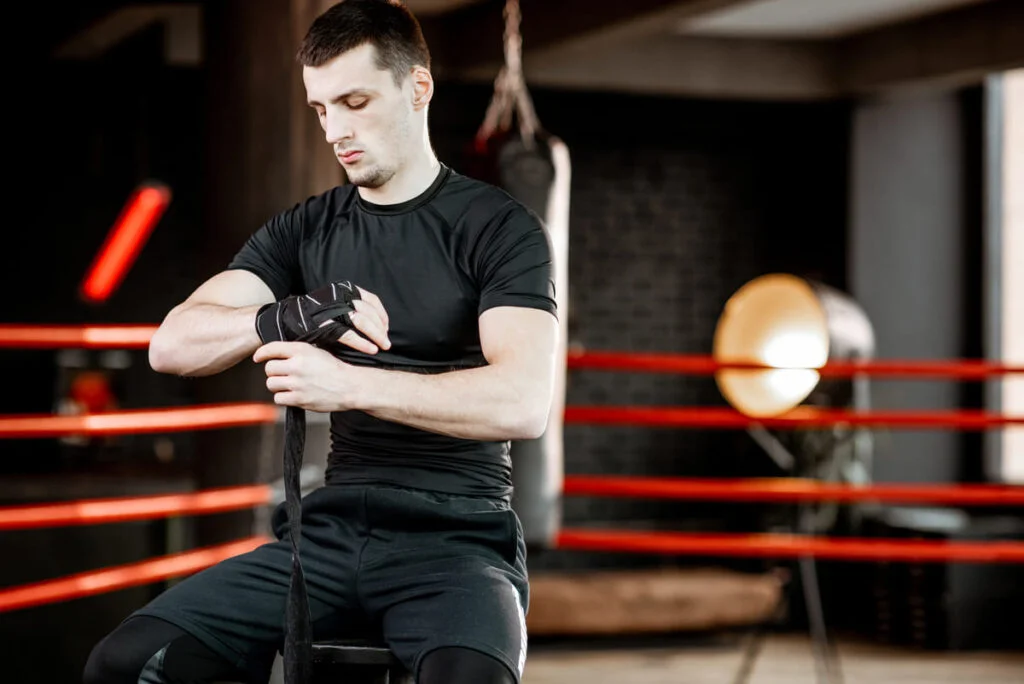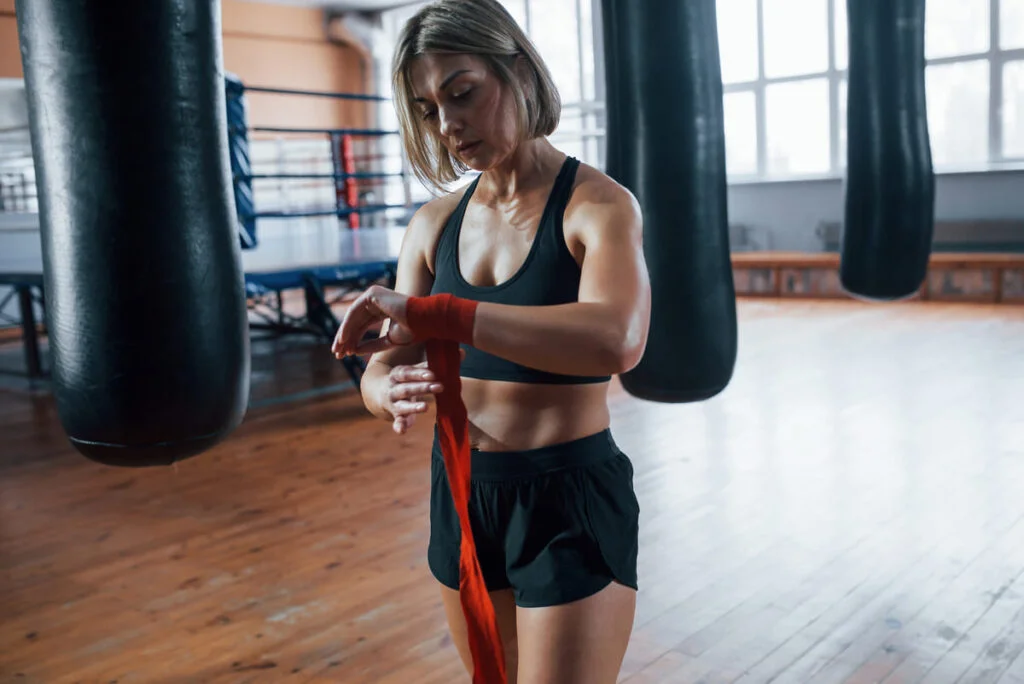When it comes to boxing and MMA training, hand protection is paramount. One of the essential tools in a fighter’s arsenal is boxing hand wraps. These simple yet effective accessories provide crucial support and stability to the hands and wrists, reducing the risk of injuries during intense training sessions and competitions. In this comprehensive guide, we will delve into the world of boxing hand wraps, exploring their purpose, types, proper usage techniques, and maintenance. By the end of this article, you will have all the knowledge you need to take your boxing game to the next level.
Key take aways
- The importance of hand wraps in boxing and MMA training.
- The different types of boxing hand wraps and their advantages and disadvantages.
- How to choose the right boxing hand wraps for your needs and preferences.
Understanding the Purpose of Boxing Hand Wraps
Boxing hand wraps play a vital role in preventing injuries and ensuring the longevity of a boxer’s career. The repetitive impact of punches can take a toll on the hands and wrists, leading to sprains, fractures, and other debilitating conditions. Hand wraps provide an additional layer of protection by stabilizing the delicate bones and tissues in the hands and wrists. They help distribute the force of impact more evenly across the entire hand, reducing the strain on specific areas.
Proper hand alignment is crucial in boxing, as it allows for more effective punches and reduces the risk of injury. Hand wraps help maintain the correct alignment by keeping the bones, tendons, and ligaments in place during training or competition. They provide support to the muscles and joints, enhancing overall hand stability and minimizing the chances of sprains or dislocations.

Types of Boxing Hand Wraps
Traditional Hand Wraps
Traditional hand wraps are the most common and widely used type of hand wraps in boxing. They consist of long pieces of fabric, typically measuring 15-18 feet in length. These wraps are manually wrapped around the hands, wrists, and knuckles, providing a personalized fit and maximum support.
1. Length and Material Options
Traditional hand wraps come in various lengths to accommodate different hand sizes and wrapping preferences. Longer wraps allow for more layers and increased protection, while shorter wraps are suitable for those who prefer a lighter feel. The material used for traditional hand wraps is usually a blend of cotton and elastic, providing both comfort and flexibility.
2. Advantages and Disadvantages
One significant advantage of traditional hand wraps is their customizability. Boxers can adjust the tightness and coverage according to their specific needs, ensuring a snug and secure fit. Additionally, traditional wraps allow for better ventilation, preventing excessive sweating and discomfort during long training sessions.
However, the process of wrapping traditional hand wraps can be time-consuming, especially for beginners. It requires practice and familiarity with the correct wrapping technique to achieve optimal results. Moreover, the repetitive use of traditional hand wraps may lead to wear and tear over time, necessitating regular replacement.
3. Effectiveness in Providing Protection
When wrapped correctly, traditional hand wraps offer excellent protection for the hands and wrists. They provide stability to the bones and joints, reducing the risk of fractures and sprains. The multiple layers of fabric act as a cushion against impact, absorbing and dispersing the force of punches.
Quick Wraps
Quick wraps, also known as slip-on or gel wraps, are a more convenient alternative to traditional hand wraps. These pre-made wraps feature a combination of fabric and gel padding, designed to offer quick and easy application.
1. Quick and Easy Application
Unlike traditional hand wraps, quick wraps eliminate the need for intricate wrapping techniques. They come with built-in wrist straps and finger loops, allowing fighters to simply slide them on and secure them in place. This makes quick wraps a popular choice for those who prefer a hassle-free and time-saving hand wrapping process.
2. Benefits and Limitations
Quick wraps provide adequate protection for the hands and wrists, making them suitable for both beginners and experienced fighters. They offer a snug and secure fit, similar to traditional wraps, without the need for meticulous wrapping. The gel padding in quick wraps adds an extra layer of cushioning, enhancing shock absorption during punches.
However, quick wraps may not offer the same level of customization and adjustability as traditional hand wraps. Fighters with unique hand shapes or specific wrapping preferences may find quick wraps less accommodating. Additionally, the gel padding in quick wraps may deteriorate over time, requiring replacement to maintain optimal protection.
3. Comparison to Traditional Hand Wraps
Both traditional hand wraps and quick wraps have their advantages and limitations. Traditional wraps offer a personalized fit and customizable coverage, making them ideal for fighters who prioritize precise hand alignment and maximum support. On the other hand, quick wraps provide convenience and ease of use, appealing to those who prefer a simpler hand wrapping process without compromising protection.
It’s important to note that the choice between traditional hand wraps and quick wraps ultimately depends on personal preference and individual needs. Some fighters may prefer the traditional feel and fine-tuned fit of hand wraps, while others may prioritize the convenience and time-saving aspect of quick wraps.
| Types of Boxing Hand Wraps | Length Options | Material | Advantages | Disadvantages | Effectiveness in Providing Protection |
|---|---|---|---|---|---|
| Traditional Hand Wraps | 15-18 feet | Cotton and elastic blend | Customizable fit, better ventilation | Time-consuming wrapping process, wear and tear over time | Excellent protection, stability, and shock absorption |
| Quick Wraps | Various lengths | Fabric and gel padding | Quick and easy application, integrated wrist strap and finger loops | Less customizable, gel padding may deteriorate over time | Adequate protection with convenience and time-saving benefits |
Choosing the Right Boxing Hand Wraps
When selecting boxing hand wraps, several factors should be taken into consideration to ensure optimal protection and comfort.

Factors to Consider When Selecting Hand Wraps
1. Length
The length of hand wraps is an essential factor to consider, as it determines the coverage and level of support they provide. Longer wraps, such as 180 inches, allow for more layers and increased protection, making them suitable for fighters who prefer a higher level of cushioning. Shorter wraps, such as 108 inches, provide a lighter feel and are suitable for those who prioritize flexibility and mobility.
2. Material
The material of the hand wraps directly affects their durability, breathability, and overall comfort. Most hand wraps are made from a blend of cotton and elastic, striking a balance between flexibility and support. Some wraps may feature additional synthetic materials for enhanced durability and sweat-wicking properties. It’s important to choose hand wraps made from high-quality materials to ensure longevity and optimal performance.
3. Thickness
The thickness of hand wraps can vary depending on the brand and model. Thicker wraps provide more cushioning and shock absorption, offering increased protection for the hands and wrists. Thinner wraps, on the other hand, provide a lighter feel and may be preferred by fighters who prioritize mobility and flexibility.
Recommendations Based on Hand Size and Personal Preference
The choice of hand wraps also depends on hand size and personal preference. Fighters with larger hands may opt for longer wraps to ensure sufficient coverage and support. Conversely, fighters with smaller hands may find shorter wraps more comfortable and easier to wrap.
It’s important to experiment with different lengths, materials, and thicknesses to find the hand wraps that best suit your individual needs. Ultimately, the goal is to find a pair of hand wraps that provide optimal protection, comfort, and support, allowing you to perform at your best during training and competition.
Case Study: The Importance of Hand Wraps in Preventing Injuries
One of the most memorable experiences I had as a boxing trainer was working with a young fighter named Jake. Jake was incredibly talented and had the potential to become a champion. However, he often neglected to properly wrap his hands before training sessions.
One day, during a sparring session, Jake threw a powerful punch and landed it square on his opponent’s head. The impact was so strong that Jake felt an intense pain shoot through his hand. He immediately knew something was wrong.
After a thorough examination, it was revealed that Jake had fractured his metacarpal bone. This injury meant that he would be out of training for several weeks, jeopardizing his chances of competing in an upcoming tournament.
This incident served as a wake-up call for Jake. He realized that he had been taking the importance of hand wraps for granted. From that point on, he made it a habit to always wrap his hands properly before every training session.
Not only did Jake’s injury heal, but he also noticed a significant improvement in his performance. With his hands properly supported and protected, he was able to throw harder punches without fear of injury. His punches became more accurate and his confidence soared.
Jake’s story is a testament to the importance of hand wraps in preventing injuries. Whether you’re a professional fighter or someone who enjoys boxing as a form of exercise, taking the time to wrap your hands properly can make all the difference in your training. It not only protects your hands and wrists from potential injuries but also enhances your overall performance in the ring. So, don’t underestimate the power of hand wraps – they may just be the key to unlocking your full potential as a boxer.
How to Wrap Your Hands with Traditional Boxing Hand Wraps
Properly wrapping your hands with traditional boxing hand wraps is crucial to ensure maximum protection and support. Here is a step-by-step guide on how to wrap your hands effectively:
Step-by-Step Instructions
- Start with the loop end of the hand wrap, slide it over your thumb, and hold it in place with your fingertips.
- Wrap the hand wrap around your wrist, making sure to cover it completely. Leave a little slack to allow for movement and flexibility.
- From the wrist, move towards the base of your thumb, crossing the back of your hand diagonally. Repeat this motion to create a crisscross pattern across the back of your hand.
- After crisscrossing, wrap the hand wrap around your knuckles several times, ensuring a snug fit without cutting off circulation.
- Once you have wrapped the knuckles, move back across the back of your hand, covering the spaces between your fingers. Make sure to provide adequate support to each finger.
- After covering the spaces between your fingers, wrap the hand wrap around your wrist again to secure it in place. Use the Velcro strip to fasten the wrap firmly but comfortably.
- Ensure that the wrapped hand feels secure, with no excessive tightness or discomfort. Gently move your hand and fingers to check for any restrictions in movement.

Techniques for Securing the Wraps around the Wrists, Knuckles, and Thumb
The wrist is a crucial area that requires proper support and stability. When wrapping your hands, pay close attention to the wrist, ensuring that it is well-covered and supported. Additionally, the knuckles and spaces between the fingers should be wrapped securely, providing adequate protection without restricting movement.
To secure the wraps around the wrists, use the Velcro strip provided at the end of the hand wrap. Make sure to fasten it firmly but comfortably, allowing for proper blood circulation and flexibility. The thumb should be wrapped along with the rest of the hand, ensuring it is supported and held in place securely.
Common Mistakes to Avoid During the Wrapping Process
While wrapping your hands, it’s essential to avoid common mistakes that can compromise the effectiveness of the hand wraps. Some common mistakes to avoid include:
- Wrapping too loosely: Insufficient tension in the hand wraps can result in inadequate support and reduced protection. Ensure that the wraps are snug, without cutting off circulation or causing discomfort.
- Wrapping too tightly: On the other hand, wrapping the hand wraps too tightly can restrict blood flow and movement, leading to discomfort and potential injury. Maintain a balance between tightness and comfort.
- Neglecting the wrist: The wrist is a vulnerable area that requires proper support. Make sure to dedicate sufficient wrapping to the wrist, ensuring stability and protection.
- Uneven wrapping: Consistency is key when wrapping your hands. Ensure that the wraps are applied evenly across the hand, knuckles, and spaces between the fingers. This helps maintain proper alignment and support.
By following these guidelines and avoiding common mistakes, you can effectively wrap your hands with traditional boxing hand wraps, providing optimal protection and stability during your training sessions and fights.
Using Quick Wraps for Convenient Hand Protection
Quick wraps offer a convenient alternative to traditional hand wraps, providing efficient hand protection with a simplified application process. Here’s a step-by-step guide on how to use quick wraps effectively:
-
Step-by-Step Instructions for Using Quick Wraps
- Insert your hand into the quick wrap, making sure your thumb is in the designated thumb loop.
- Pull the quick wrap tightly around your wrist, ensuring a secure fit. The integrated wrist strap should be fastened firmly but comfortably.
- Proceed to wrap the quick wrap around your hand, covering the knuckles and spaces between the fingers.
- Use the Velcro closure to secure the quick wrap in place, ensuring it is snug but not overly tight.
- Gently move your hand and fingers to check for any discomfort or restrictions in movement.
Quick wraps are designed to streamline the hand wrapping process, offering a hassle-free and time-saving solution. The integrated wrist strap and finger loops make application quick and easy, allowing fighters to focus more on their training rather than spending time on intricate wrapping techniques. Quick wraps are especially beneficial for those who prefer a simplified hand wrapping process or have limited time between training sessions.

Comparing the Effectiveness of Quick Wraps to Traditional Hand Wraps
Quick wraps provide comparable protection to traditional hand wraps, as they feature built-in padding and support. The gel padding in quick wraps offers excellent shock absorption, reducing the impact on the hands and wrists during punches. However, it’s important to note that the level of customization and adjustability may be slightly limited with quick wraps compared to traditional wraps. Fighters with specific wrapping preferences or hand shapes may find traditional hand wraps more accommodating.
Final thoughts on boxing hand wraps
Boxing hand wraps play an indispensable role in protecting fighters during training and competitions. They provide essential support to hands and wrists, reducing injury risks. Two primary types exist: traditional wraps and quick wraps. Traditional wraps, typically 15-18 feet long made of a cotton and elastic blend, offer a customizable fit and better ventilation but require more time to apply. Quick wraps are lauded for their convenience, providing protection with a much-simplified application process. However, their gel padding might deteriorate over time. The choice between the two boils down to personal preference, with some valuing precision and fit while others prioritize speed and ease. Remember Jake’s story: neglecting proper hand protection can have dire consequences. Whichever wrap type you choose, ensure optimal protection, comfort, and support for peak performance. Safety first!
The most FAQ’s about Boxing Wraps
What are boxing hand wraps used for?
Boxing hand wraps provide support and protection for your hands and wrists during training or fights.
Who needs to use boxing hand wraps?
Anyone involved in boxing, MMA, or martial arts training should use hand wraps for added safety.
How do I properly wrap my hands for boxing?
Start by placing the loop around your thumb and wrap the cloth around your wrist and knuckles, securing it with Velcro.
What makes boxing hand wraps essential?
Hand wraps prevent injuries by stabilizing your hand and wrist, reducing the risk of fractures and sprains.
How long should boxing hand wraps be?
Most hand wraps are around 180 inches long, providing enough length to wrap your hands securely.
What if I find hand wraps uncomfortable?
Try adjusting the tightness and technique of wrapping. Alternatively, consider trying different brands or materials.

